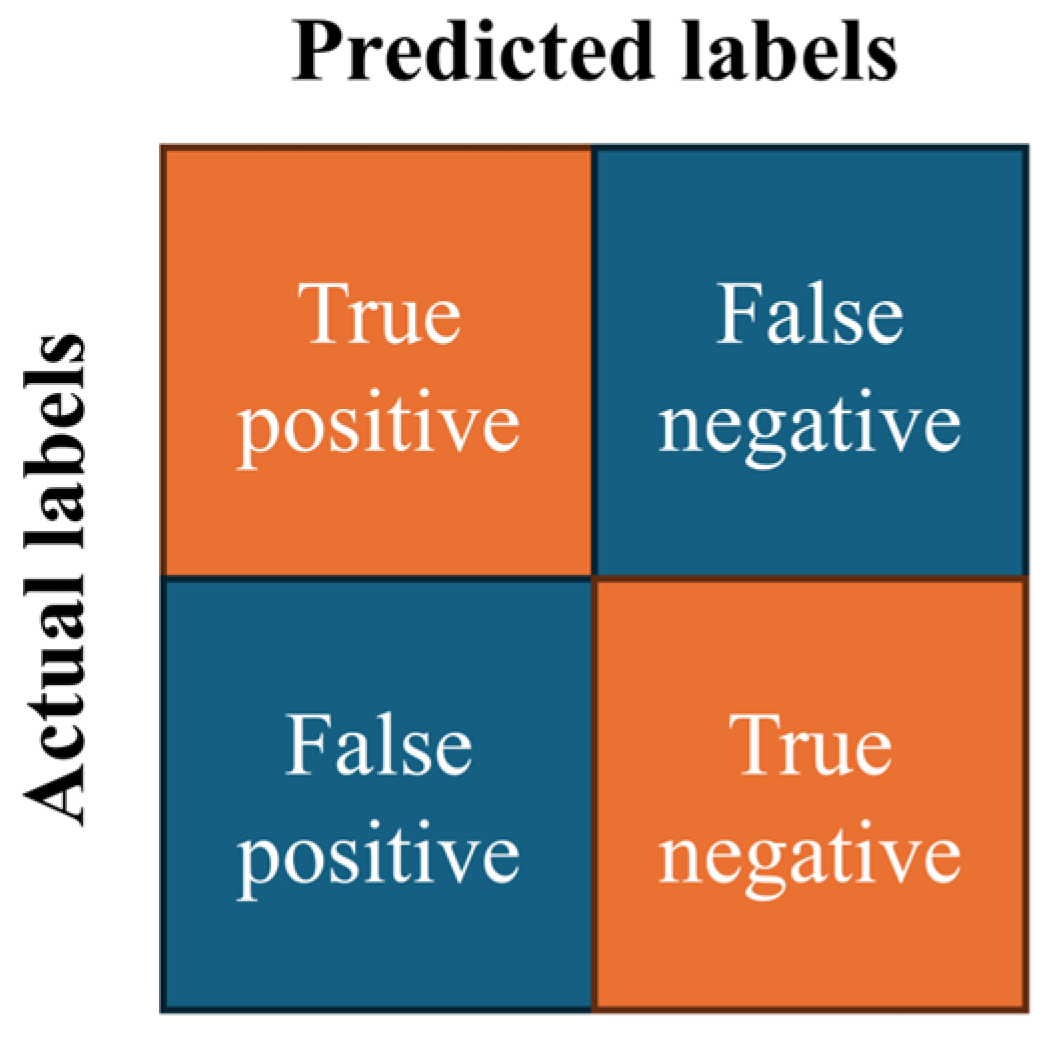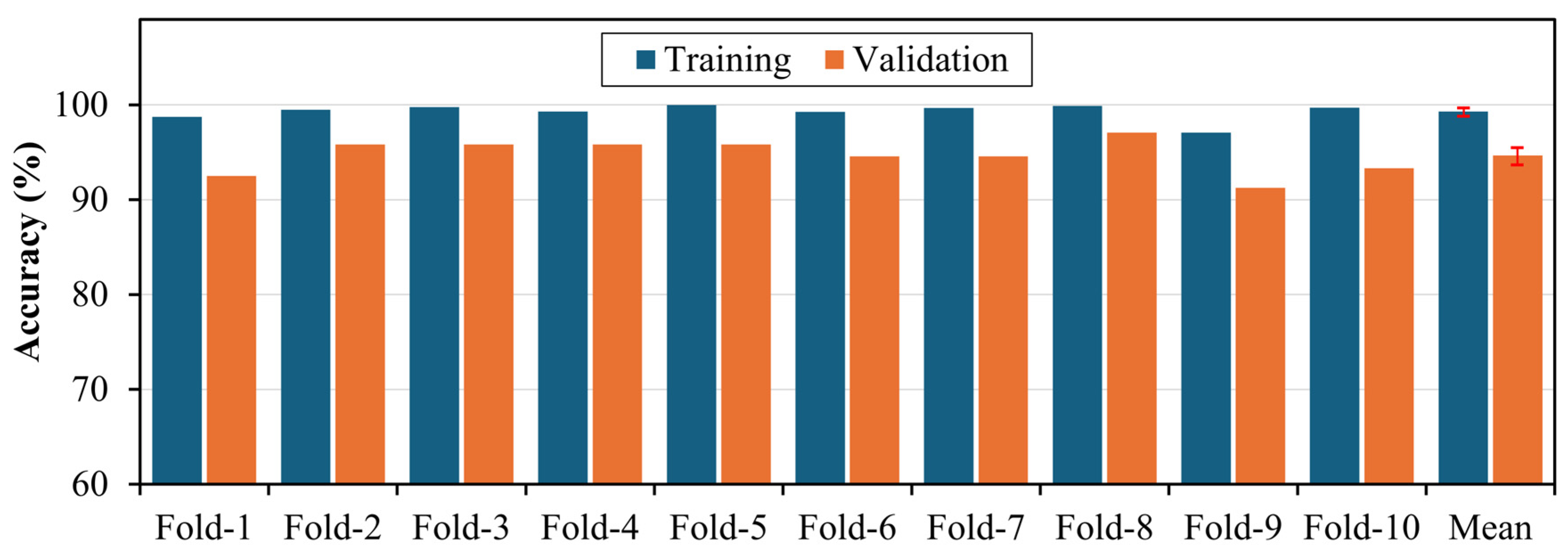Structural Health Monitoring of Laminated Composites Using Lightweight Transfer Learning
Abstract
1. Introduction
2. The Proposed Methodology
2.1. Convolutional Neural Network (CNN)
2.2. Transfer Learning
2.3. EfficientNet Model
2.4. Performance Evaluation Metrics
3. Vibration Data for Composite Laminates
3.1. Dataset Description
3.2. Data Conversion and Splitting
4. Results and Validation
5. Conclusions
Author Contributions
Funding
Data Availability Statement
Conflicts of Interest
References
- Azad, M.M.; Cheon, Y.; Raouf, I.; Khalid, S.; Kim, H.S. Intelligent Computational Methods for Damage Detection of Laminated Composite Structures for Mobility Applications: A Comprehensive Review. Arch. Comput. Methods Eng. 2024, 1–29. [Google Scholar] [CrossRef]
- Chang, H.-S.; Huang, J.-H.; Tsai, J.-L. Predicting Mechanical Properties of Unidirectional Composites Using Machine Learning. Multiscale Sci. Eng. 2022, 4, 202–210. [Google Scholar] [CrossRef]
- Khalid, S.; Kim, H.S. Recent Studies on Stress Function-Based Approaches for the Free Edge Stress Analysis of Smart Composite Laminates: A Brief Review. Multiscale Sci. Eng. 2022, 4, 73–78. [Google Scholar] [CrossRef]
- Chen, R.; Li, S.; Zhou, Y.; Qiu, X.; Li, P.; Zhang, H.; Wang, Z. Damage Formation and Evolution Mechanisms in Drilling CFRP with Prefabricated Delamination Defects: Simulation and Experimentation. J. Mater. Res. Technol. 2023, 26, 6994–7011. [Google Scholar] [CrossRef]
- Khan, A.; Kim, H.S. A Brief Overview of Delamination Localization in Laminated Composites. Multiscale Sci. Eng. 2022, 4, 102–110. [Google Scholar] [CrossRef]
- Raouf, I.; Lee, H.; Kim, H.S. Mechanical Fault Detection Based on Machine Learning for Robotic RV Reducer Using Electrical Current Signature Analysis: A Data-Driven Approach. J. Comput. Des. Eng. 2022, 9, 417–433. [Google Scholar] [CrossRef]
- Azimi, M.; Eslamlou, A.; Pekcan, G. Data-Driven Structural Health Monitoring and Damage Detection through Deep Learning: State-of-the-Art Review. Sensors 2020, 20, 2778. [Google Scholar] [CrossRef]
- Staszewski, W.J.; Mahzan, S.; Traynor, R. Health Monitoring of Aerospace Composite Structures—Active and Passive Approach. Compos. Sci. Technol. 2009, 69, 1678–1685. [Google Scholar] [CrossRef]
- Li, D.; Zhou, J.; Ou, J. Damage, Nondestructive Evaluation and Rehabilitation of FRP Composite-RC Structure: A Review. Constr. Build. Mater. 2021, 271, 121551. [Google Scholar] [CrossRef]
- Toh, G.; Park, J. Review of Vibration-Based Structural Health Monitoring Using Deep Learning. Appl. Sci. 2020, 10, 1680. [Google Scholar] [CrossRef]
- Zhang, C.; Mousavi, A.A.; Masri, S.F.; Gholipour, G.; Yan, K.; Li, X. Vibration Feature Extraction Using Signal Processing Techniques for Structural Health Monitoring: A Review. Mech. Syst. Signal Process. 2022, 177, 109175. [Google Scholar] [CrossRef]
- Zou, C.; Ibrahim, Z.; Hashim, H.; Jamadin, A.; Ayough, P. Nonlinear Analysis of Reinforced Concrete Slabs under High-Cyclic Fatigue Loading. J. Mater. Res. Technol. 2022, 21, 992–1012. [Google Scholar] [CrossRef]
- Diaz-Escobar, J.; Díaz-Montiel, P.; Venkataraman, S.; Díaz-Ramírez, A. Classification and Characterization of Damage in Composite Laminates Using Electrical Resistance Tomography and Supervised Machine Learning. Struct. Control Health Monit. 2023, 2023, 1675867. [Google Scholar] [CrossRef]
- Gu, R.; Li, Y.; Zhang, S.; Zhu, J.; Pang, X.; Liu, Z. Structural Vibration-Based Identification of Delamination in CFRP Cylinders Using Complex Frequency Domain Correlation and CNN. Compos. Struct. 2023, 321, 117299. [Google Scholar] [CrossRef]
- Viotti, I.D.; Gomes, G.F. Delamination Identification in Sandwich Composite Structures Using Machine Learning Techniques. Comput. Struct. 2023, 280, 106990. [Google Scholar] [CrossRef]
- Ijjeh, A.A.; Ullah, S.; Kudela, P. Full Wavefield Processing by Using FCN for Delamination Detection. Mech. Syst. Signal Process. 2021, 153, 107537. [Google Scholar] [CrossRef]
- Hernández-García, A.; König, P. Further Advantages of Data Augmentation on Convolutional Neural Networks. In Proceedings of the 27th International Conference on Artificial Neural Networks, Rhodes, Greece, 4–7 October 2018; pp. 95–103. [Google Scholar]
- Tang, S.; Yuan, S.; Zhu, Y. Data Preprocessing Techniques in Convolutional Neural Network Based on Fault Diagnosis towards Rotating Machinery. IEEE Access 2020, 8, 149487–149496. [Google Scholar] [CrossRef]
- Khan, A.; Raouf, I.; Noh, Y.R.; Lee, D.; Sohn, J.W.; Kim, H.S. Autonomous Assessment of Delamination in Laminated Composites Using Deep Learning and Data Augmentation. Compos. Struct. 2022, 290, 115502. [Google Scholar] [CrossRef]
- Tan, X.; Sun, X.; Chen, W.; Du, B.; Ye, J.; Sun, L. Investigation on the Data Augmentation Using Machine Learning Algorithms in Structural Health Monitoring Information. Struct. Health Monit. 2021, 20, 2054–2068. [Google Scholar] [CrossRef]
- Mumuni, A.; Mumuni, F. Data Augmentation: A Comprehensive Survey of Modern Approaches. Array 2022, 16, 100258. [Google Scholar] [CrossRef]
- Özdemir, Ö.; Sönmez, E.B. Attention Mechanism and Mixup Data Augmentation for Classification of COVID-19 Computed Tomography Images. J. King Saud Univ. Comput. Inf. Sci. 2022, 34, 6199–6207. [Google Scholar] [CrossRef]
- Raouf, I.; Kumar, P.; Lee, H.; Kim, H.S. Transfer Learning-Based Intelligent Fault Detection Approach for the Industrial Robotic System. Mathematics 2023, 11, 945. [Google Scholar] [CrossRef]
- Fotouhi, S.; Pashmforoush, F.; Bodaghi, M.; Fotouhi, M. Autonomous Damage Recognition in Visual Inspection of Laminated Composite Structures Using Deep Learning. Compos. Struct. 2021, 268, 113960. [Google Scholar] [CrossRef]
- Zhao, J.; Xie, W.; Yu, D.; Yang, Q.; Meng, S.; Lyu, Q. Deep Transfer Learning Approach for Localization of Damage Area in Composite Laminates Using Acoustic Emission Signal. Polymers 2023, 15, 1520. [Google Scholar] [CrossRef] [PubMed]
- Rai, A.; Mitra, M. A Transfer Learning Approach for Damage Diagnosis in Composite Laminated Plate Using Lamb Waves. Smart Mater. Struct. 2022, 31, 065002. [Google Scholar] [CrossRef]
- Wang, Y.; Luo, Q.; Xie, H.; Li, Q.; Sun, G. Digital Image Correlation (DIC) Based Damage Detection for CFRP Laminates by Using Machine Learning Based Image Semantic Segmentation. Int. J. Mech. Sci. 2022, 230, 107529. [Google Scholar] [CrossRef]
- Saeed, N.; King, N.; Said, Z.; Omar, M.A. Automatic Defects Detection in CFRP Thermograms, Using Convolutional Neural Networks and Transfer Learning. Infrared Phys. Technol. 2019, 102, 103048. [Google Scholar] [CrossRef]
- Wu, D.; Chen, D.; Yu, G. New Health Indicator Construction and Fault Detection Network for Rolling Bearings via Convolutional Auto-Encoder and Contrast Learning. Machines 2024, 12, 362. [Google Scholar] [CrossRef]
- Albelwi, S.; Mahmood, A. A Framework for Designing the Architectures of Deep Convolutional Neural Networks. Entropy 2017, 19, 242. [Google Scholar] [CrossRef]
- Jiang, C.; Zhou, Q.; Lei, J.; Wang, X. A Two-Stage Structural Damage Detection Method Based on 1D-CNN and SVM. Appl. Sci. 2022, 12, 10394. [Google Scholar] [CrossRef]
- Iosifidis, A.; Tefas, A. Deep Learning for Robot Perception and Cognition; Academic Press: Cambridge, MA, USA, 2022; ISBN 0/323/88572/1. [Google Scholar]
- Azad, M.M.; Kumar, P.; Kim, H.S. Delamination Detection in CFRP Laminates Using Deep Transfer Learning with Limited Experimental Data. J. Mater. Res. Technol. 2024, 29, 3024–3035. [Google Scholar] [CrossRef]
- Liu, H.-I.; Galindo, M.; Xie, H.; Wong, L.-K.; Shuai, H.-H.; Li, Y.-H.; Cheng, W.-H. Lightweight Deep Learning for Resource-Constrained Environments: A Survey. ACM Comput. Surv. 2024, 56, 1–42. [Google Scholar] [CrossRef]
- Simonyan, K.; Zisserman, A. Very Deep Convolutional Networks for Large-Scale Image Recognition. arXiv 2014, arXiv:14091556. [Google Scholar]
- Chen, F.; Li, S.; Han, J.; Ren, F.; Yang, Z. Review of Lightweight Deep Convolutional Neural Networks. Arch. Comput. Methods Eng. 2023, 31, 1915–1937. [Google Scholar] [CrossRef]
- Chollet, F. Xception: Deep Learning with Depthwise Separable Convolutions. In Proceedings of the IEEE Conference on Computer Vision and Pattern Recognition, Honolulu, HI, USA, 21–26 July 2017; pp. 1251–1258. [Google Scholar]
- Ma, N.; Zhang, X.; Zheng, H.-T.; Sun, J. Shufflenet v2: Practical Guidelines for Efficient Cnn Architecture Design. In Proceedings of the European Conference on Computer Vision (ECCV), Munich, Germany, 8–14 September 2018; pp. 116–131. [Google Scholar]
- Konovalenko, I.; Maruschak, P.; Brezinová, J.; Prentkovskis, O.; Brezina, J. Research of U-Net-Based CNN Architectures for Metal Surface Defect Detection. Machines 2022, 10, 327. [Google Scholar] [CrossRef]
- Tan, M.; Le, Q. Efficientnet: Rethinking Model Scaling for Convolutional Neural Networks. In Proceedings of the International Conference on Machine Learning, PMLR, Long Beach, CA, USA, 10–15 June 2019; pp. 6105–6114. [Google Scholar]
- Atila, Ü.; Uçar, M.; Akyol, K.; Uçar, E. Plant Leaf Disease Classification Using EfficientNet Deep Learning Model. Ecol. Inform. 2021, 61, 101182. [Google Scholar] [CrossRef]
- Sandler, M.; Howard, A.; Zhu, M.; Zhmoginov, A.; Chen, L.-C. Mobilenetv2: Inverted Residuals and Linear Bottlenecks. In Proceedings of the IEEE Conference on Computer Vision and Pattern Recognition, Salt Lake City, UT, USA, 18–22 June 2018; pp. 4510–4520. [Google Scholar]
- Sokolova, M.; Lapalme, G. A Systematic Analysis of Performance Measures for Classification Tasks. Inf. Process. Manag. 2009, 45, 427–437. [Google Scholar] [CrossRef]
- Galar, M.; Fernández, A.; Barrenechea, E.; Bustince, H.; Herrera, F. An Overview of Ensemble Methods for Binary Classifiers in Multi-Class Problems: Experimental Study on One-vs-One and One-vs-All Schemes. Pattern Recognit. 2011, 44, 1761–1776. [Google Scholar] [CrossRef]
- Aslan, M. CNN Based Efficient Approach for Emotion Recognition. J. King Saud Univ. Comput. Inf. Sci. 2022, 34, 7335–7346. [Google Scholar] [CrossRef]
- Liu, Y.; Li, Z.; Zhang, W. Crack Detection of Fibre Reinforced Composite Beams Based on Continuous Wavelet Transform. Nondestruct. Test. Eval. 2010, 25, 25–44. [Google Scholar] [CrossRef]









| Transfer Learning Model | Number of Parameters (Million) | Size of Model (Mbs) |
|---|---|---|
| AlexNet | 61.10 | 233.07 |
| DenseNet-121 | 8.06 | 30.44 |
| ResNet-50 | 25.64 | 97.59 |
| VGG-16 | 138.36 | 527.79 |
| InceptionV3 | 23.85 | 90.86 |
| NASNetMobile | 5.32 | 20.18 |
| MobileNet | 4.25 | 16.14 |
| EfficientNet | 5.33 | 20.17 |
| Health State | LTL Model | Precision (%) | Recall (%) | F1-Score (%) |
|---|---|---|---|---|
| D1 | NASNetMobile | 82.44 | 84.50 | 83.46 |
| MobileNet | 90.38 | 94.00 | 92.16 | |
| EfficientNet | 93.91 | 92.50 | 93.20 | |
| D2 | NASNetMobile | 80.20 | 79.00 | 79.60 |
| MobileNet | 90.00 | 90.00 | 90.00 | |
| EfficientNet | 92.00 | 92.00 | 92.00 | |
| H | NASNetMobile | 88.38 | 87.50 | 87.94 |
| MobileNet | 97.40 | 93.50 | 95.41 | |
| EfficientNet | 97.54 | 99.00 | 98.26 |
Disclaimer/Publisher’s Note: The statements, opinions and data contained in all publications are solely those of the individual author(s) and contributor(s) and not of MDPI and/or the editor(s). MDPI and/or the editor(s) disclaim responsibility for any injury to people or property resulting from any ideas, methods, instructions or products referred to in the content. |
© 2024 by the authors. Licensee MDPI, Basel, Switzerland. This article is an open access article distributed under the terms and conditions of the Creative Commons Attribution (CC BY) license (https://creativecommons.org/licenses/by/4.0/).
Share and Cite
Azad, M.M.; Raouf, I.; Sohail, M.; Kim, H.S. Structural Health Monitoring of Laminated Composites Using Lightweight Transfer Learning. Machines 2024, 12, 589. https://doi.org/10.3390/machines12090589
Azad MM, Raouf I, Sohail M, Kim HS. Structural Health Monitoring of Laminated Composites Using Lightweight Transfer Learning. Machines. 2024; 12(9):589. https://doi.org/10.3390/machines12090589
Chicago/Turabian StyleAzad, Muhammad Muzammil, Izaz Raouf, Muhammad Sohail, and Heung Soo Kim. 2024. "Structural Health Monitoring of Laminated Composites Using Lightweight Transfer Learning" Machines 12, no. 9: 589. https://doi.org/10.3390/machines12090589
APA StyleAzad, M. M., Raouf, I., Sohail, M., & Kim, H. S. (2024). Structural Health Monitoring of Laminated Composites Using Lightweight Transfer Learning. Machines, 12(9), 589. https://doi.org/10.3390/machines12090589







